#P.P.O.W NYC
Explore tagged Tumblr posts
Text


“A beautiful figure without a tongue”, 2024, oil and pencil on canvas


“Open Season”, 2024, oil and pencil on canvas


“Where our love once lay, a dark and tortured jungle grew”, 2023, oil and pencil on canvas
A sense of foreboding looms over the paintings in Sanam Khatibi’s exhibition We Wait Until Dark at P.P.O.W gallery. In the details are smaller skeletons, ritual objects, and dead animals blood soaks the ground. Life and death are personified in both the figures and the natural surroundings. Flowers bloom or wilt, bones are scattered, a hummingbird shares a moment with a skeleton in one painting while a dead bird lies on the ground in another. Khatibi’s works have many potential meanings, like their art historical predecessors, and leave it to the viewer to come to their own conclusions.
From the press release-
…People who devote their lives to art can often cite an event that placed them on their destined path. Among the earliest memories Belgian artist Sanam Khatibi recalls is the day she discovered a book on Hieronymous Bosch left out on the table by her mother. She was five. That one might advance from consuming the rapturous reproductions of The Garden of Earthly Delights at such a young age to painting expansive, primal scenes of a troubled Paradise is one excellent example of artistic “fate.”
In Khatibi’s paintings and sculptures, the veil between desire and restraint, life and death, and the natural and spirit worlds proves thin. Again and again, the artist returns to the figure of a nude goddess navigating a verdant, savage land beyond the protective scrim of “civilization.” In the absence of technology, politics, bills, e-mail, and even clothing, she exhibits her most feral qualities for survival: devouring, eating, attacking, killing, and hunting. Khatibi’s subjects are perennial (desire, seduction, domination, submission), and her references to allegorical forms are extensive (17th-century Dutch still life vanitas, the motif of Death and the Maiden, antiquarian amulets, and anthropological relics), all channeled into displays of human folly and erotic obsession.
Paintings by Khatibi are full of expressions of voracity: for sex, earthly delights, experience, and transcendence, and what happens when you tempt the devil. In Where our love once lay, a dark and tortured jungle grew (2023), a fey skeleton seizes a beautiful maiden by the hair under a lightening blue sky –– a grotesque quid pro quo that recalls Lucas Cranach the Elders’ The Ill-Matched Couple (1553); or even Kawanabe Kyōsai’s Hell Courtesan (1831–1889). Decrepit and aging, his skull sprouts strawlike strands of hair, the last indication of vitality. In Open Season (2024), an Amazonian goddess places an intimate offering of amulets and animal sacrifices before a pool of water. There is a sense of reckless abandon: a human skull, a pomegranate cracked open, blood spilling over the cerulean earth––a feast for ravenous souls.
Khatibi’s Eden is repeatedly transformed into a Bosch-like tale of passionate, potentially fatal encounters (a locus amoenus turned upside down into a “locus terribilis”). In A beautiful figure without a tongue (2024), the skeletal personification of Death reappears. A maniacal grin spreads across his decaying face as he slinks away, clutching an ornate vase to his chest. Are these the spoils of Death to be hoarded in a cavernous underworld?
Throughout the exhibition, Khatibi faithfully intertwines two genres of painting (figurative landscape and still life), leaving seemingly ancillary details from one scene to reveal as sharp memento mori in another––as in Overnight Black Aphids Appeared, growing on the tips of the Sophora Sun King (2023). Here, the reappearance of skulls, amulets, and small creatures sans personnages gives the impression of a romantic sojourn set apart from the larger narrative. Each of Khatibi’s objects pulses into realism with near-scientific observation, appearing magnificent and fragile, possibly even forbidden. Placed against a velvety black ground, they fall into shadow as if pulled amorously into the afterlife. –Lola Kramer
Also included in the exhibition are several smaller works, like the one pictured below. In these darker paintings the details stand out against their black background, but the mystery of their meaning remains.

“Overnight Black Aphids Appeared, growing on the tips of the Sophora Sun King”, 2023 oil on canvas
#Sanam Khatibi#P.P.O.W#P.P.O.W Gallery#Painting#Allegory#Art#Art Shows#Death#Life and Death#New York Art Shows#NYC Art Shows#P.P.O.W NYC#Still Life#Symbolism
1 note
·
View note
Photo
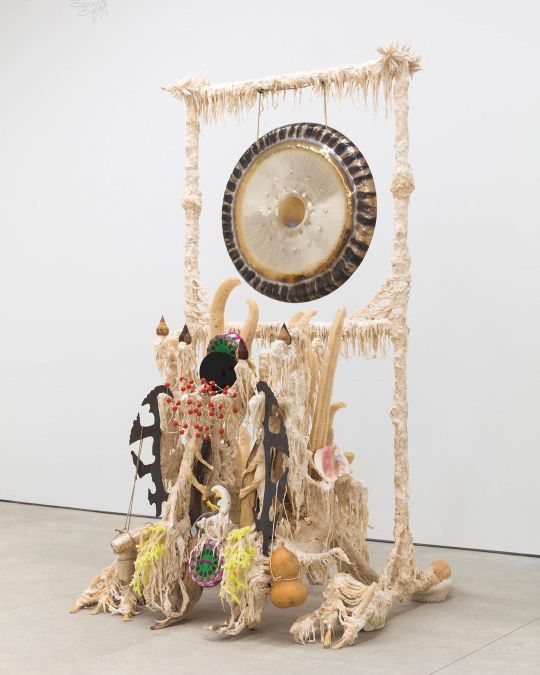
Seven Ancestral Stomachs — Solo presentation by Guadalupe Maravilla at P.P.O.W Gallery, New York, US On view until March 27, 2021 @guadalupe__maravilla @ppowgallery 🔗 in stories 👀 #GuadalupeMaravilla #PPOWGallery #newyork #newyorkexhibitions #us #nyc #nycexhibitions #soloshow #soloexhibition #sculpture #painting #installation #art #contemporrayart #ofluxo #ofluxopatform @ofluxoplatform (em New York, New York) https://www.instagram.com/p/CMAKR42lafk/?igshid=55fc3u3la6cl
#guadalupemaravilla#ppowgallery#newyork#newyorkexhibitions#us#nyc#nycexhibitions#soloshow#soloexhibition#sculpture#painting#installation#art#contemporrayart#ofluxo#ofluxopatform
55 notes
·
View notes
Text
8.7.22 Manhatten & Munson
I’m sat in a cafe in nyc. I paid $8 for a coffee and poor wifi connection but I just saw a great art show next door that was full of collected objects of femininity. Stuff for girls all tied together. Endless pinks. ‘Today will be awesome.’ Portia Munson. “While the individual objects in Today Will Be Awesome, 2022, were manufactured to sell confidence, positivity, and success to young women, Munson’s accumulation of them exposes their suffocation, violence, and victimization.” (P.P.O.W. GALLERY) Everything I spent my youth avoiding.
I think I thought I was a solitary creature but I keep talking to strangers.
Being here is making me think of last time. When I walked the city alone because my then partner was at work during the day. I don’t remember feeling this self aware but maybe I was just young. I don’t remember if I had come out yet when I was last here, but I think I was binding, I must have been. I must have been moving between spaces some how, oscillating into new selves, buying all these American clothes as though I could be that guy one day. Go Nets!
What I saw was a simpler life and a simpler future for myself. But that wasn’t based on fact, that was based on being an entirely different person. It was based on being cis. So it was a bit of a long shot. I get hit by waves of this simplicity occasionally, it all seems so clear. If I was that guy my life would be so easy, wow I would wake up each morning and put on one of those plain t-shirts and some jeans and just stroll out the house without a bag. Just my wallet in my pocket and my phone in my hand. (I’m too much of a Capricorn for this to ever be my truth.) I go to the same pub to see the lads on Fridays and I work out regularly enough but not too intensely but it doesn’t matter because I’m not insecure and I don’t have hips. I cycle without a helmet.
Does it turn you on when you put a tampon in?
Munson’s work pulled me back to a series of shapes I used to try and fit into. For the most part I moved relatively freely as a little tomboy but once those hormones kicked in for my peers it was a different ball game. I clung to my scrappy tomboy look for as long as I could, I got my period a little later than some of those girls from school and I was adamant that things didn't need to change. Why were we just sat around at lunch time talking? I still wanted to play! I could feel this comfortable space slipping away, change was all around me and I was stubbornly planting my feet. I feel sad for that kid, so fearful of puberty and what it signified. That kid wouldn’t feel comfortable for the next 13 years.
[I do historically have a tendency to fall into the trap of ‘When I have X I will be happy’. X can be any number of things that I’m waiting to happen or waiting to achieve or receive. But X is not happiness.]
0 notes
Text
Don’t Inhale The Paint Fumes: Week of 11/12
Thoughts, notes and links to things I’ve read, worn and watched.

Ahh, art! Our respite from – or at times most honest reflection of – the wild times we live in.
Art has a way of speaking to us in a language we don’t speak, but that we can understand perfectly well. How does something static – words on a page, dried paint on canvas – conduct so much energy?
Fortunately for us NYC dwellers art abounds! And fortunately for you reading from different zip codes nearly everything is accessible on the internet (Google image searches strongly advised).
Some current exhibits that are worth a gander, and conveniently located near popular subway lines:
Robin F. William - Your Good Taste is Showing at P.P.O.W.
“In her third exhibition with P.P.O.W, Williams extends her longstanding interest in gender roles to the strangeness of feminine identity in our current moment…The exhibition features works at the intersection of genre painting and portraiture; women in unexpected, awkward, and uncomfortable poses. These scenarios humorously explore the absurd standards to which women are still expected to conform. For this exhibition Williams turned to vintage advertising, particularly ads from the 70s, which drew on representational painting as a common aesthetic – a notion that fascinated her – and which sold to women sanctioned substitutes for their authentic desires.” - Artsy.net
• Your Good Taste is Showing – P.P.O.W. Gallery
Toyin Ojih Odutola - To Wander Determined at The Whitney
This chick is a serious bad ass. I went through this exhibit twice (truthfully because I had misread the artist statement and confused the whole collection), and I could go again.
Her interview with Vogue is worth reading in full, but I’ve pulled what I consider her most pointed quote below:
[The news is] exhausting. My concern as an artist is to reveal things in as subtle ways as I can. There’s this nostalgia: “make America great again.” White men are feeling stifled, like they can’t speak freely. They’re not accounted for. One of the things I tried to inject into this series was constantly hearing about the mediocrity of white men, how that was no longer helping them move through the world. Because, yes, it’s a globalized, capitalistic system. You can’t just be mediocre. You can’t just fall back on your whiteness and your maleness as a thing that can get you ahead. You have to do a little more—you feel me, guys? Maybe put your tiki torches down and try something new. Because everyone here is hustling just to be seen, and all of us have to be exceptional to do so. You have been unremarkable for a very, very long time. I wanted to show an unremarkability: Yeah, I’m in the middle of a gorgeous home, with a green chair, and a see-through skirt, and a paisley tee, and I’m just living my life. There’s no other purpose besides that. And that is a luxury that’s been afforded a group of people for a very long time, until very recently. But in order for me to create that piece, I have to be extraordinary. I have to work twice as hard to make this picture look unremarkable. That was what I was pushing at, what seeped in. Because I kept hearing it all summer, with all the statues, the protests, it was like, Everyone is very angry. And I don’t understand where this anger is coming from. The people who should be angry are in Flint, Michigan. - Odutola for Vogue
• Toyin Ojih Odutola: To Wander Determined - The Whitney
Richard Avendon - Nothing Personal
Avendon was pals with James Baldwin and photographed interesting and amazing people including Marilyn Monroe and MLK III. See the show and gift the book to the artistically inclined social activist on your holiday shopping list. Your welcome.
“Avedon collaborated with Baldwin, his old high school friend, who wrote a cri de coeur of astonishing eloquence about the absence of common dignity in America, denouncing the false myths and damaging racial and ethnic hierarchies, and, ultimately, abjectly, pointing to the deep and abiding loneliness that underlies the glossy veneer of American optimism put forward by Hollywood and the media.”
• Richard Avedon - Nothing Personal at Pace
Currently overdue at the Brooklyn Public Library (whoops) is Barbara Kingsolver’s love letter to the natural world, Prodigal Summer. I’ve finished the book, but can’t quite accept that fact. I don’t want to leave the delicious world Kingsolver has created in the summer hills of the Appalachian Mountains. Especially not as it approaches 40°
“Solitude is a human presumption. Every quiet step is thunder to beetle life underfoot, a tug of impalpable thread on the web pulling mate to mate and predator to prey, a beginning or an end. Every choice is a world made new for the chosen.” - Barbara Kingsolver Prodigal Summer
But art in-takers beware! Standing in awe of remarkable works of art can actually produce a psychological effect known as Stendhal Syndrome.
Apparently, the exposure to aesthetically stimulating objects incite the feeling of repulsion and attraction at the same time. Many prominent philosophers like Immanuel Kant have rightly expressed that excessive imagination can become a tool for the loss of the self. The involuntary emotion projection witnessed while watching artworks is commonly referred to as Stendhal’s syndrome…a psychosomatic illness, triggered due to exposure to extensive or exquisite pieces of artworks. People suffering from this syndrome may experience a host of symptoms including heart palpitations that may result in panic attacks, intense dizziness, confusion and disorientation, nausea, dissociative episodes, temporary amnesia, paranoia, and hallucinations and temporary madness in some extreme cases. These symptoms may also surge when individuals feel intoxicated by the sublime beauty of nature, such as a sunset or a sunrise. - Anxiety Treatment Advisors
The absence of this, yes real, and yes, super weird disorder is what has some folks saying the $100 million Davinci that sold this past week at a high rollers Christy auction was a ripoff. Out of the 4,000+ visitors to view the peice – few left in stretchers.
• Get in Line: The $100 Million da Vinci Is in Town - NY Times
So, get out there and expand your visual horizons. But as with all things in life, do so in moderation.
Something tells me art overdose isn’t an excuse your boss with likely believe.
Peace, love and pastel painted nippes.
Yours,
Nomi
12 notes
·
View notes
Photo

"Visual Notes on an Upside-Down World" is on view at P.P.O.W. in NYC through August 18. Louise Bourgeois, Femme, 2005, bronze, silver nitrate patina. #monahatoum #louisebourgeois #rachelwhiteread #hughhayden #jackmcgrath #alexmctigue #upsidedown #femme #nyc #gallery @ppowgallery #visualnotes (at PPOW Gallery)
#rachelwhiteread#visualnotes#monahatoum#hughhayden#gallery#femme#upsidedown#nyc#louisebourgeois#jackmcgrath#alexmctigue
1 note
·
View note
Photo

🎀 T H E C O F F I N. 🎀 ・・・ #portiamunson #findingmagic #viewfromhere #vscocam #nyc #instagramnyc #instagood #goodvibes #vscogood #vsco #newyorkcity #perspective #vsconyc #reflection #igers #vscofeature #explore #instagram #newyork #manhattan #gallery #installation #contemporaryart #light #exploretocreate #chelseagalleries #ppow #whpdisguise #feministart (at P.P.O.W)
#vsconyc#instagram#chelseagalleries#findingmagic#perspective#portiamunson#feministart#ppow#newyorkcity#vscogood#nyc#vscocam#manhattan#contemporaryart#newyork#explore#igers#viewfromhere#instagramnyc#vsco#vscofeature#gallery#exploretocreate#installation#reflection#light#whpdisguise#instagood#goodvibes
0 notes
Photo
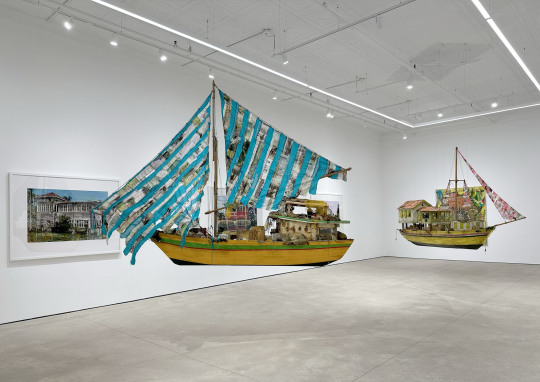
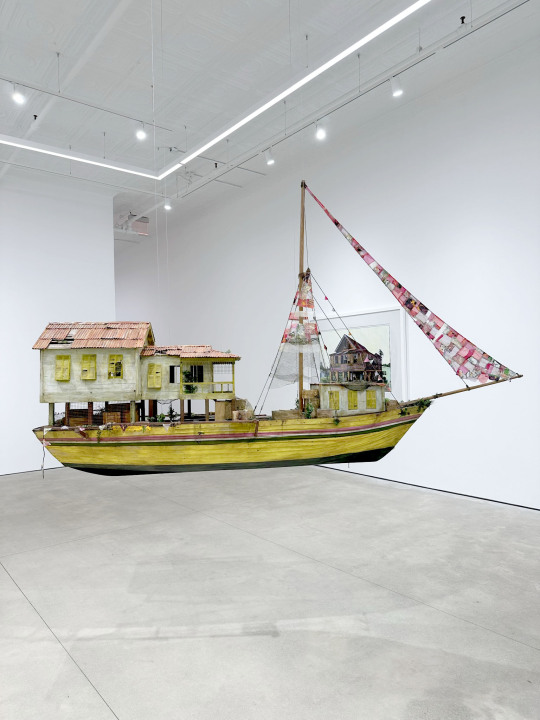
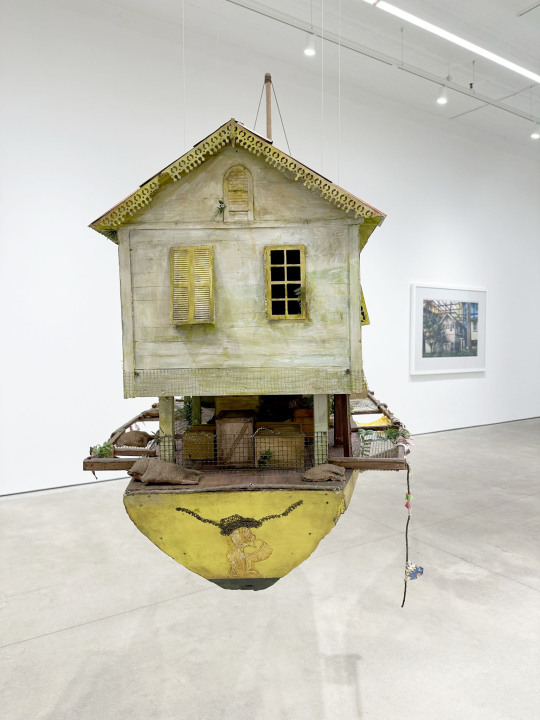
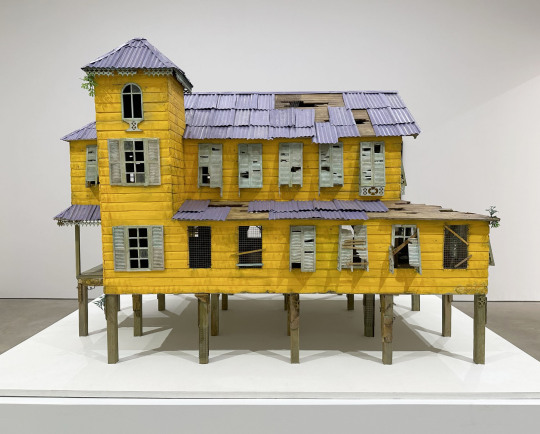
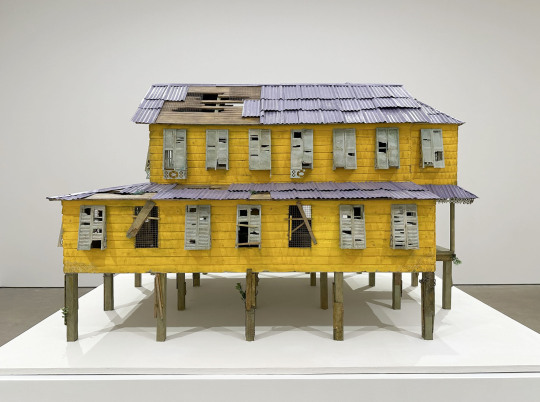
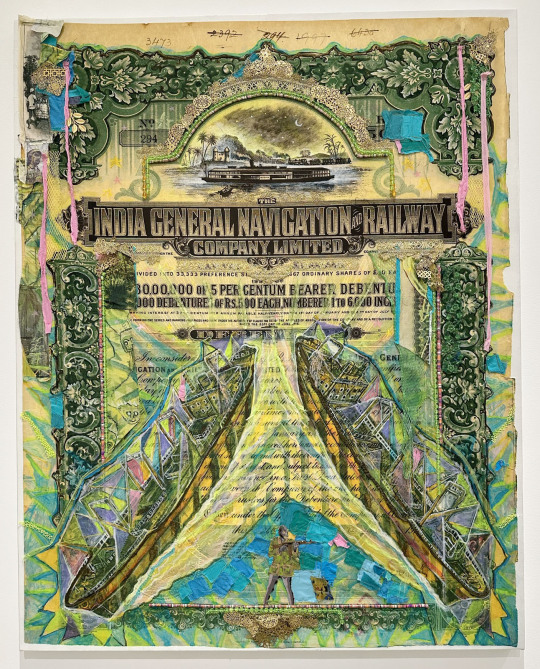


For Hew Locke’s exhibition, Listening to the Land, at P.P.O.W. he has created intricate sculptures and paintings that are fascinating in person.
From the press release-
Locke is known for exploring the languages of colonial and post-colonial power, and the symbols through which different cultures assume and assert identity. Furthering the themes explored in his celebrated commission The Procession at Tate Britain, and his concurrent installation Gilt on the façade of The Metropolitan Museum of Art, this exhibit engages with contemporary and historical inequities while reflecting on the landscape and history of the Caribbean. The exhibition draws its title from a poem by Guyanese political activist and poet Martin Carter which situates itself between two opposing forces of the landscape – sea and forest. Locke’s show features new sculptures and wall works with recurring motifs of stilt-houses, boats, memento mori, and share certificates referencing tensions between the land, the sea, and economic power. Reflecting on these links, Locke notes, “The land was created to generate money for colonial power, now the sea wants it back.”
Translating to ‘land of many waters,’ Guyana and its physical, economic, and political landscape serve as one of the primary sources for Locke’s work. Having spent his childhood in this newly independent nation, the artist witnessed first-hand an era of radical transformation. Now, the country teeters on the precipice of an oil boom and is one of the world’s fastest growing economies. Juxtaposing personal meditations on the climate crisis with political commentary on the history of a globalized world, Locke contemplates the ways in which colonies were exploited to accumulate capital, and observes how Guyana’s economic future lies in the exploitation of its waters. Locke’s new boat sculptures The Relic and The Survivor embody this broad worldview as the two battered wrecks drift through time and history. Evoking the fragmented and diverse legacies of the global diaspora, the boats’ patchwork sails are interspersed with photo transfers of 19th Century cane cutters and banana boat loaders, while their decks are loaded with cargo that could allude to colonial plunder, trade goods or personal belongings.
Based on an abandoned plantation house, Locke’s newest sculpture Jumbie House 2 features layered images that unveil the spirits that haunt this colonial vestige. Presented alongside are a series of painted photographs of dilapidated vernacular architecture across Georgetown and rural Guyana. Constantly under threat of being washed away by storms or rising sea levels, these crumbling structures echo anxieties surrounding climate change and historical erasure. A new series of mixed media wall works, Raw Materials, is derived from antique share certificates and bonds. Locke richly decorates the appliques with acrylic, beads, and patchwork to draw attention to the complex ways in which the past shapes the present. The image of an 1898 Chinese Imperial Gold Loan behind painted Congolese figures connects the global economy at the height of Empire to current Sino-African trade networks. In another work, a painted representation of a Nigerian Ife mask, alongside an image of David Livingstone, is layered on a French-African Mortgage Bond from 1923, connecting exploration and exploitation of African land, to current conversations surrounding the repatriation of artifacts. Taken together, the works in Locke’s Listening to the Land echo William Faulkner’s adage “The past is never dead. It’s not even past.”
This exhibition closes 4/1/23.
The Procession, mentioned above, can now be seen at Baltic Centre for Contemporary Art, in Gateshead, England until June 11th, 2023.
Gilt, also mentioned above, is on view at The Metropolitan Museum of Art until May 30th, 2023.
#hew locke#p.p.o.w#p.p.o.w gallery nyc#nyc art shows#sculpture#art installation#painting#guyana#baltic centre for contemporary art#the met#the metropolitan museum of art#uk art shows#art#art shows#models#photography#england art shows#gateshead#newcastle
15 notes
·
View notes
Photo





For Adam Putnam’s recent exhibition Holes at P.P.O.W gallery in New York, he takes the visitor on a multimedia journey into the self.
From P.P.O.W’s press release-
Through the building up of imagery by means of photography, drawing, sculpture, film, and performance, Adam Putnam continues an ongoing exploration of the boundaries between architecture, nature, the physical and the internal self, often using one as a stand in for the other.
A single, hand-carved wooden finger beckons the viewer toward a labyrinth of 365 “visualizations.” Initiated during the long months of lockdown, this mass of miniature drawings takes on an elusive arrangement, like an archaic diagram of the unconscious mind, with patterns emerging and dissolving as the visitor weaves through the space. Accompanying this accumulation are a new series of drawings and photographs, depicting architectural inversions and other implements such as a crumbling brick column and a rusty sword.
The labyrinth ultimately leads to a shadowy monolith vibrating with light, smoke and bubbles. Based on a 2022 site- specific, multi-sensory work commissioned in response to the experiential interests and preferences of a small group of people with Profound Mental and Learning Disabilities (PMLD) living in Midlothian, Scotland, the tower, which can be viewed alternately as a lighthouse, clocktower, steeple and sundial, aims to connect through touch, scent, light and sound. As we enter a post-pandemic world, Holes offers an opportunity for collective experience and contemplation of the otherworldliness imbedded in the everyday.
Putnam’s Instagram is currently private, but you can check out his Tarot influenced artwork here. He was giving Tarot readings throughout the duration of the show using his handmade cards.
#adam putnam#nyc art shows#p.p.o.w#p.p.o.w gallery nyc#tarot cards#mixed media#drawing#painting#art shows#sculpture#art installation#new york city art shows
0 notes
Photo

Currently on view at P.P.O.W. in NYC is a group exhibition: "Visual Notes for an Upside-Down World." Mona Hatoum, + and, 1994, hardwood, steel blades, motor and sand. #monahatoum #louisebourgeois #rachelwhiteread #hughhayden #jackmcgrath #alexmctigue #upsidedown #nyc #gallery @ppowgallery #visualnotes (at PPOW Gallery)
#louisebourgeois#upsidedown#alexmctigue#nyc#jackmcgrath#gallery#rachelwhiteread#monahatoum#visualnotes#hughhayden
0 notes
Photo

🌺 T H E G A R D E N. 🌸 ・・・ #findingmagic #thegarden #viewfromhere #vscocam #nyc #instagramnyc #instagood #goodvibes #vscogood #vsco #newyorkcity #perspective #vsconyc #reflection #igers #vscofeature #explore #instagram #newyork #manhattan #gallery #installation #contemporaryart #light #exploretocreate #chelseagalleries #ppow #portiamunson #whpdisguise (at P.P.O.W)
#vsconyc#instagram#chelseagalleries#findingmagic#perspective#portiamunson#ppow#newyorkcity#vscogood#thegarden#nyc#vscocam#manhattan#contemporaryart#newyork#explore#igers#viewfromhere#instagramnyc#vsco#vscofeature#gallery#exploretocreate#installation#reflection#light#whpdisguise#instagood#goodvibes
0 notes